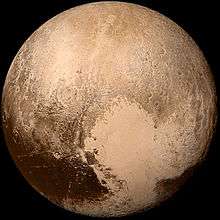(307616) 2003 QW90
| Discovery | |
|---|---|
| Discovered by | Marc W. Buie[1] |
| Discovery date | 23 August 2003 |
| Designations | |
| none | |
| TNO | |
| Orbital characteristics[2] | |
| Epoch 13 January 2016 (JD 2457400.5) | |
| Uncertainty parameter 3 | |
| Observation arc | 2945 days (8.06 yr) |
| Aphelion | 46.988 AU (7.0293 Tm) |
| Perihelion | 40.234 AU (6.0189 Tm) |
| 43.611 AU (6.5241 Tm) | |
| Eccentricity | 0.077434 |
| 288.01 yr (105195 d) | |
Average orbital speed | 4.50 km/s |
| 275.158° | |
| 0° 0m 12.32s / day | |
| Inclination | 10.385° |
| 17.757° | |
| 89.888° | |
| Earth MOID | 39.2673 AU (5.87430 Tm) |
| Jupiter MOID | 35.1022 AU (5.25121 Tm) |
| Jupiter Tisserand parameter | 5.797 |
| Physical characteristics | |
| Dimensions | 366 km (assumed)[3] |
| Temperature | ≈42 K |
| 5.4[2] | |
|
| |
(307616) 2003 QW90 is a classical Kuiper belt object that was discovered on August 23, 2003, by Marc W. Buie. In 2008, its diameter was listed as 440 kilometres (270 mi).[4]
References
- ↑ "List Of Transneptunian Objects". Retrieved 2015-08-26.
- 1 2 Alan Chamberlin. "JPL Small-Body Database Browser". Ssd.jpl.nasa.gov. Retrieved 7 April 2016.
- ↑ "List of known trans-Neptunian objects". Retrieved 2009-03-24.
- ↑ Wm. Robert Johnston (22 August 2008). "List of Known Trans-Neptunian Objects". Johnston's Archive. Archived from the original on 2009-04-18. Retrieved 2008-12-09.
External links
This article is issued from Wikipedia - version of the 8/31/2016. The text is available under the Creative Commons Attribution/Share Alike but additional terms may apply for the media files.
_(cropped).jpg)
